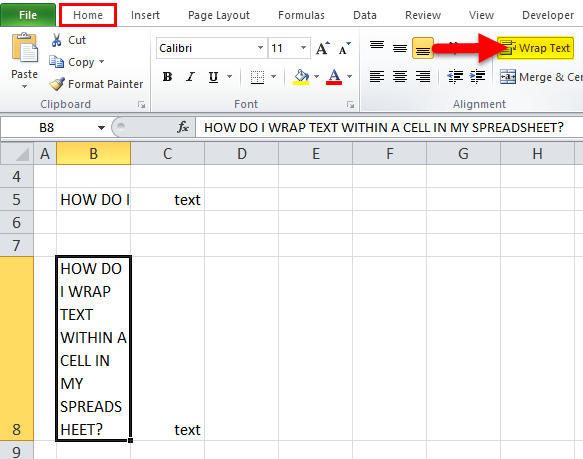

The Row Height box will appear showing the current height of the selected cells. On the Home tab, in the Cells group, click Format > Row Height. Which method do you use most to word wrap? What is the quickest for you?. Before wrapping text, this is what you need to do: Select the cells you wish to stop from spilling over. Note: if you manually set a row height (by clicking on the bottom. Double click the bottom border of the row 1 header to automatically adjust the row height. In case the adjacent cell also has some text, the text in A1 won’t overflow. You can see, when the text is unwrapped the text overflows from cell A1 to adjacent cells. Step 2: Highlight the cells that need to be fixed Highlight the cells that need to be fixed. Let’s check out an example to see how wrapped and unwrapped text looks like in Excel. Click on the right border of the column A header and drag the separator to increase the column width. Edit the field that is wrapping incorrectly, highlight a space in the text and copy that character using CTRL C or right-click and Copy.

Be aware that youll still need to keep the columnwidth wide enough for the. (hit and hold the ctrl key while striking the j key) Toggle wrap text (formatcellsalignment tab) And adjust the rowheight manually. In my example I want to word wrap after Sales On the Home tab, in the Alignment group, click Wrap Text. You can use a custom format of: dddd (ctrl-j)dd. In the formula bar place the cursor after the place where you want your work to wrap. To make this label look better and my spreadsheet more clear I can wrap the text into cell A1.Īgain I have typed Yearly Sales Figures into cell A1, this time to manually wrap the text in both < 2007 and Excel 2007Ģ. I have typed in cell A1 Yearly Sales Figures, when I pressed enter, it spills over to cell B1 and C1. In VBA, there is a property called WrapText that you can access to apply wrap text to a cell or a range of cells. I will take you through both methods – use which one you feel more comfortable with.Īs usual it is way easier to use an example. Sometimes even if the text is already wrapped the user can not see all the writings of a section. Either way it is a great tool to allow more control over the look and feel of your labels and titles in Excel to really give your worksheets that edge. One automatically and the other manually. I tried the below code: writer pd.ExcelWriter (outfilename, engine'xlsxwriter') dfinput.toexcel (writer, sheetname'Inputs') workbook writer.book worksheetinput writer.sheets 'Inputs. There are two ways in Excel to wrap your text in cells. textwrap format gets ignored using worksheet formatting.


 0 kommentar(er)
0 kommentar(er)
